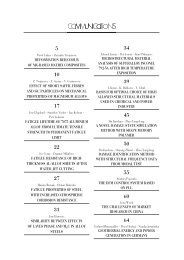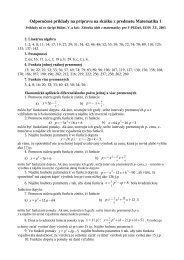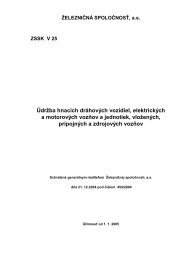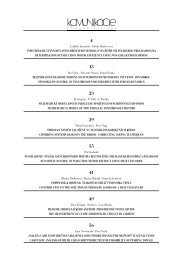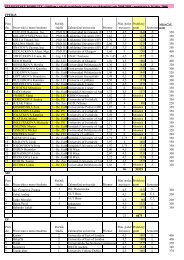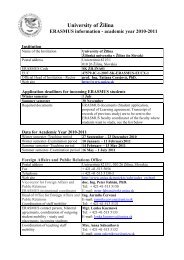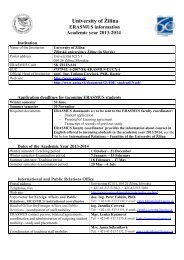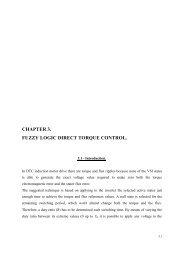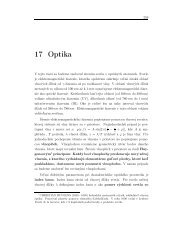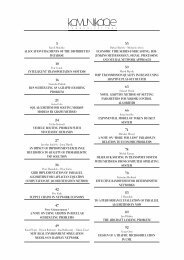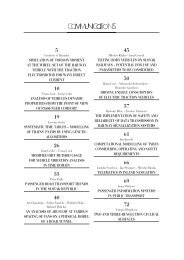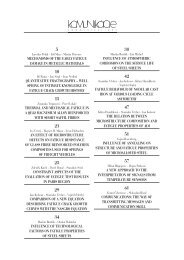posudzovanie vplyvu automobilovej dopravy na ... - Žilinská univerzita
posudzovanie vplyvu automobilovej dopravy na ... - Žilinská univerzita
posudzovanie vplyvu automobilovej dopravy na ... - Žilinská univerzita
Create successful ePaper yourself
Turn your PDF publications into a flip-book with our unique Google optimized e-Paper software.
C O M M U N I C A T I O N S<br />
I S<br />
Zygmunt Szlachta – Jerzy Cisek *<br />
DODATOČNÉ VSTREKOVANIE PALIVA DO VALCA VZNETOVÉHO<br />
MOTORA AKO METÓDA ZNIŽOVANIA NO x<br />
THE DIESEL FUEL POST-INJECTION INTO ENGINE CYLINDER AS METHOD<br />
OF NO x REDUCTION<br />
Možnosti obmedzovania emisií NO x vo valci vznetového motora pri jeho konštrukcii alebo prostredníctvom prevádzkových parametrov sú<br />
limitované. Preto sa robia štúdie efektívnosti rôznych metód znižovania NO x vo výfukových plynoch. Metóda, ktorú použili autori, využíva redukčného<br />
činiteľa vo forme chemicky aktívnych uhľovodíkov (radikálov) z paliva. Aby sa získali čiastočne oxidované a tepelne rozložené uhľovodíky,<br />
aplikoval sa dodatočný vstrek (vstreknutie ďalšej časti paliva) do valca vznetového motora v priebehu expanzie. Na vyko<strong>na</strong>nie tejto funkcie sa<br />
skonštruoval špeciálny systém <strong>na</strong> dodávku paliva skladajúci sa z dvoch vstrekovacích čerpadiel. Jedno z čerpadiel vstrekovalo hlavnú (primárnu)<br />
dávku paliva, druhé vstrekovalo dodatočnú dávku paliva. Vstrekovanie oboch dávok paliva bolo realizované rov<strong>na</strong>kým vstrekovačom. Vo výfukovom<br />
systéme jednovalcového testovacieho motora sa použil katalytický konvertor a všetky výfukové plyny vytvorené spaľovaním hlavnej dávky<br />
paliva a chemicky aktivované uhľovodíky pochádzajúce z dodatočnej dávky paliva prechádzali cez konvertor. Na vyhodnotenie dosiahnutých<br />
výsledkov sa definovali rôzne postupy zamerané <strong>na</strong> efektívne znižovanie NO x . Počas testov sa menil uhol vstreku hlavnej i dodatočnej dávky<br />
paliva (vzhľadom <strong>na</strong> hornú úvrať) ako aj teplota, priestorová rýchlosť výfukových plynov prechádzajúcich cez konvertor a druh paliva.<br />
Zistilo sa, že ak sa použije metóda redukčného činiteľa, je celkový efekt redukcie NO x kombináciou efektov získaných vo valci selektívnou<br />
nekatalytickou redukciou a účinkov v katalytickom konvertore získaných selektívnou katalytickou redukciou.<br />
The possibilities of limiting the emission of nitrogen oxides in the cylinder of the diesel engine by means of its design and operating parameters<br />
are limited. This is why studies of the effectiveness of various methods for NO x reduction in exhaust gases are being undertaken. The<br />
method used by the authors involves the utilization of a reducing agent in the form of chemically active hydrocarbons (radicals) from the fuel.<br />
In order to obtain partially oxidized and thermally decomposed hydrocarbons, the post-injection of fuel (the injection of an additio<strong>na</strong>l portion<br />
of fuel) into the diesel engine cylinder during the expansion stroke was implemented. To perform this function, a special fuel supply system<br />
consisting of two injection pumps was designed. One of the pumps was injecting the main (primary) fuel dose, and the other one – the additio<strong>na</strong>l<br />
fuel dose. Injection of both fuel doses was accomplished by the same injector. A catalytic converter was used in the exhaust system of the<br />
one-cylinder test engine, and all the exhaust gases produced in the combustion of the main diesel fuel dose and chemically activated hydrocarbons<br />
coming from the fuel post-injection (additio<strong>na</strong>l fuel dose) were passing through the converter. Various NO x reduction efficiency measures<br />
were defined to evaluate the results obtained. During the tests, the additio<strong>na</strong>l diesel fuel dose and post-injection angle (relative to the TDC), as<br />
well as temperature, space velocity of exhaust gases through converter and sort of diesel fuel were changed.<br />
It was found that using that method of the reducing agent dosage, the total effect of nitrogen oxide reduction was a combi<strong>na</strong>tion of the<br />
effects obtained in the engine cylinder by Selective Non-Catalytic Reduction (SNR) and the effects obtained in the catalytic converter by Selective<br />
Catalytic Reduction (SCR).<br />
1. Introduction<br />
The issue of NO x emission reduction pertains not only to diesel<br />
engine exhaust gases, but also to the spark ignition, petrol-fuelled<br />
engine. However, in the conventio<strong>na</strong>l spark-ignition engine, the<br />
problem of particulates emission is not so important as in the<br />
diesel engine, where particulates are produced during the combustion<br />
of heterogeneous mixtures, specific to the diesel engine.<br />
Nitrogen oxide emission in petrol engines has been limited to the<br />
level imposed by the relevant standards by the common use of threeway<br />
catalytic converters, reducing also other toxic constituents of<br />
the exhaust gases (CO, HC). This concept is not useful in the<br />
diesel engine whose exhaust gases contain a significant amount of<br />
oxygen [4]. For this reason, research projects initiated currently<br />
aim to develop efficient NO x emission reduction methods, based<br />
on the proven technologies for NO x elimi<strong>na</strong>tion from exhaust gases<br />
typical for the chemical industry and power industry.<br />
According to the results of tests [19, 22, 23], nitrogen oxides<br />
generated in the process of burning diesel fuel in the diesel engine<br />
can be reduced by two methods: Selective Non-Catalytic Reduction<br />
(SNR) and Selective Catalytic Reduction (SCR). The former<br />
* Zygmunt Szlachta, Assoc. Prof., D.Sc., Ph.D., M.E., Jerzy Cisek, Ph.D., M.E.,<br />
Institute of Automobiles and Inter<strong>na</strong>l Combustion Engines, Cracow University of Technology, 31-155 Kraków, ul. Warszawska 24, Poland.<br />
Tel./Fax.: ++48-12- 6282047, E-mail: z.szlachta@usk.pk.edu.pl, jcisek@usk.pk.edu.pl<br />
26 ● KOMUNIKÁCIE / COMMUNICATIONS 1/2003



